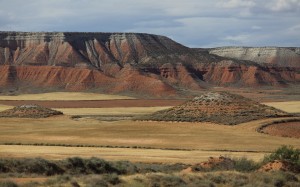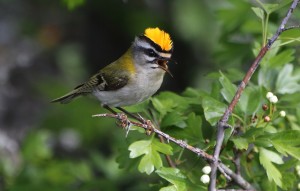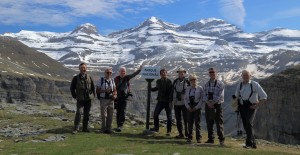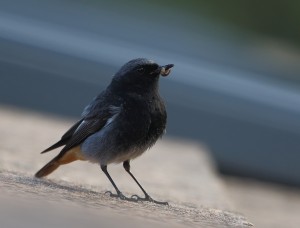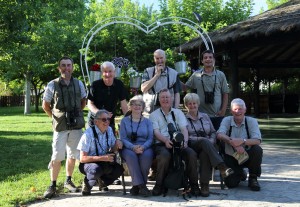 So, here we are in the Ebro delta, where a pre-dinner stroll amongst the rice fields around the hotel produces Squacco Heron, Little Bittern, Glossy Ibis, Black-winged Stilt, Audouin’s Gull and Spotless Starling, as well as Whiskered and Gull-billed Terns, flying together and showing the marked size difference between them, but, bird of the day is a Penduline Tit, posing on reed stems right in front of us back in the hotel grounds! So, not a bad start to the list.
So, here we are in the Ebro delta, where a pre-dinner stroll amongst the rice fields around the hotel produces Squacco Heron, Little Bittern, Glossy Ibis, Black-winged Stilt, Audouin’s Gull and Spotless Starling, as well as Whiskered and Gull-billed Terns, flying together and showing the marked size difference between them, but, bird of the day is a Penduline Tit, posing on reed stems right in front of us back in the hotel grounds! So, not a bad start to the list.
Torrential rain first thing slightly delays our departure, but things are soon back to ‘normal’. Crossing the Ebro to the south side of the delta, via a bridge where there used to be a ferry, our first sighting is a ‘Billy no mates’ Cattle Egret in smart breeding plumage, followed by brilliant scope views of loads of Collared Pratincoles and Purple Swamphens in an otherwise empty ploughed field, with a lovely Woodchat Shrike a little further along the track. The Alfacada reserve is teeming with birds such as Great White and Little Egrets, Red-crested Pochard, Avocet, Greenshank, Black-tailed Godwit, Grey Plover in full breeding plumage, Marsh Harrier, Common, Little, Whiskered and Gull-billed Terns, Slender-billed Gull, Greater Flamingo, Hoopoe, Crested Lark, Yellow Wagtail, Spotted Flycatcher, Zitting Cisticola and a sunbathing Purple Heron, as well as some big Carp thrashing about in the shallows while spawning. Moving on to the Riet Vell reserve, we find Willow Warbler and Pied and Spotted Flycatchers in the same small lemon tree, while the hide provides views of a roosting Night Heron, a few Spoonbills and plenty of Flamingos. After a lovely open air picnic lunch smart Whinchats are next on the list. Heading south on a long narrow sand spit reminiscent of the access to Spurn Point, new birds include Turnstone, Sanderling, Knot, a locally scarce Oystercatcher, Kentish Plover, Sandwich Terns, really close views of more Audouin’s Gulls and a very obliging Collared Pratincole. Back in the delta, I casually suggest that we need Caspian Tern, and within minutes our local guide Joan spots one in flight which shows really well once we are all out of the van, making six different terns today! A little further inland, we find Great Reed Warbler singing its croaky song from the reed tops despite the strong breeze. Back at the hotel, we score late in the day yet again, with a Scops Owl peeping out of a nest box just outside the front door, bringing the day list to a respectable 71 different birds.
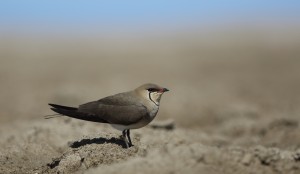 After a group photo in the floral grounds of the Delta Hotel, we say “adios” to the Ebro delta and head northwest through a scenic landscape of terraced olive groves and limestone cliffs, where a brief stop produces a Honey Buzzard accompanied by Alpine Swifts, plus Red-rumped Swallow, Serin and great views of Crested Tit. We are now in the big sky country of Lower Aragon, amidst a wide open tree less landscape of arid steppe bordered by multicoloured cliffs, reminiscent of the ‘wild west badlands’ and alive with singing Calandra, Short-toed, Lesser Short-toed and Thekla Larks, and all scoped well. Other sightings here include Red-legged Partridge, Little Owl, Black-eared Wheatear, Spectacled Warbler, Southern Grey Shrike, Chough, Corn Bunting and a variety of raptors including Kestrel, Black Kite, Marsh and Montagu’s Harriers, Booted and Short-toed Eagles and a sub adult Golden Eagle, which shows really well while mobbed by a tiny Marsh Harrier! We have now seen 100 different birds in just three days.
After a group photo in the floral grounds of the Delta Hotel, we say “adios” to the Ebro delta and head northwest through a scenic landscape of terraced olive groves and limestone cliffs, where a brief stop produces a Honey Buzzard accompanied by Alpine Swifts, plus Red-rumped Swallow, Serin and great views of Crested Tit. We are now in the big sky country of Lower Aragon, amidst a wide open tree less landscape of arid steppe bordered by multicoloured cliffs, reminiscent of the ‘wild west badlands’ and alive with singing Calandra, Short-toed, Lesser Short-toed and Thekla Larks, and all scoped well. Other sightings here include Red-legged Partridge, Little Owl, Black-eared Wheatear, Spectacled Warbler, Southern Grey Shrike, Chough, Corn Bunting and a variety of raptors including Kestrel, Black Kite, Marsh and Montagu’s Harriers, Booted and Short-toed Eagles and a sub adult Golden Eagle, which shows really well while mobbed by a tiny Marsh Harrier! We have now seen 100 different birds in just three days.
With five larks ‘in the bag’ yesterday, we leave the hotel before dawn for ‘Operation Dupont’s Lark’, back in the ‘badlands’, where the dawn chorus includes the slow melancholy whistles of our target bird. Our patience is soon rewarded with a perfect profile view in the scope of this elusive lark, singing in full view with its decurved beak, barely thirty yards away, just one minute before the sun peeps over the eastern slopes! Mission accomplished, with high fives all round. It is remarkable how this bird melts away so easily in such scant vegetation. With the pressure now off, a relaxed scan of the area, produces scope views of Short-toed and Booted Eagles, perched not too far apart, along with one, no two, then three and finally four Stone Curlews, all from just one spot, followed by a handsome male Black-eared Wheatear! After a later than normal breakfast back at the hotel, it’s time to head for the hills. On the way to the foothills of the Pyrenees, a Great Spotted Cuckoo flashes by and we marvel at the amount of bulk which has gone into some of the White Storks’ nests which occupy every available post on the outskirts of Zaragoza, including some supports with two and even three nests. The imposing Castillo de Loarre is a picturesque and productive location, with Woodlark, Tawny Pipit, Blue Rock Thrush and the beautifully marked Rock Bunting all singing in the scope, along with Bonelli’s Warbler in the nearby pines right above our heads! After a picnic lunch in this beautiful setting, with Red and Black Kites floating around, we move on to the towering pinnacles above Riglos, home to Peregrines, Crag Martins, Choughs, Griffon and Egyptian Vultures and Cirl Bunting. As we head higher into the spectacular Pyrenean foothills, we make an emergency stop for the first Lammergeier of the trip, with its diagnostic long pointed tail, before finding two more circling at the head of the lovely Osia valley, where the peaks still bear the remnants of last winter’s snow. Going from one extreme to the other we also enjoy incredible views here of a feisty Firecrest with a stunning incandescent ‘hairdo’! In spite of all this, Dupont’s Lark is still bird of the day.
While yesterday was ‘Dupont’s Lark day’, today is ‘the day of the Wallcreeper’. Black Redstart and a low circling Egyptian Vulture are waiting right outside the hotel followed by a pair of Red-backed Shrikes a little further out of sleepy Siresa. At the end of the road to the Gabardito mountain refuge, we set off on ‘Operation Wallcreeper’, enjoying super views of Marsh Tit, Nuthatch and a vocal Short-toed Treecreeper in the tall beechwoods. Beyond the trees the track meets a cliff face alive with dozens of House and Crag Martins, and the stake out begins. After twenty minutes or so, Joan excitedly calls “Wallcreeeper” and after a bit of frantic searching and neck-breaking tracking as it flutters to and fro on broad moth-like wings, this elusive bird settles on the point of a rock. With the scope trained in a near vertical position we take turns to kneel behind it as if in worship of this almost mythical bird, obligingly sitting perfectly still in the view, showing off his blood-red wing patches, black throat, black blinking eye and long fine decurved bill. What an amazing achievement to get fantastic scope views of two of Europe’s most highly sought birds in consecutive days! Mission accomplished we move on up the Hecho valley, through a plunging ravine known as La Boca del Infierno, to a gorgeous natural picnic site beside the river, perfect for Dipper and Grey Wagtail. Higher up the valley, we find the lemon yellow male Citril Finch and a family of six Alpine Marmots, sunbathing on rocks. Watching them in the scope is like watching a scene from a BBC wildlife documentary, and as we stroll up this beautiful tranquil valley, within sight of the French border along the ridgeline, we find plenty more Marmots, sunbathing, playing tag and wrestling, as well as a herd of at least twenty eight Chamois, a large flock of Alpine and Red-billed Choughs and a pink-flushed Pyrenean Water Pipit. You wait all day for a Dipper and then two come along at once!
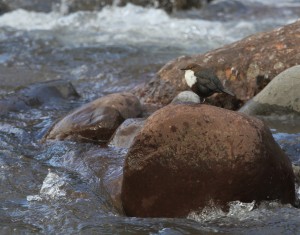 Today we are leaving Siresa and heading further east along the Pyrenean range, with a stop after half an hour to check out the Mediterranean scrub, with plum views of Ortolan Bunting and Melodious Warbler, both singing from prominent perches. I had forgotten just how pretty and yellow the Melodious Warbler is. Other good sightings here include a Tawny Pipit posing on a nearby rock, another Egyptian Vulture, and a Honey Buzzard cruising by at low level and slow enough to show off all its features. Moving on to the monastery of San Juan de la Peña, Subalpine Warbler is a new bird for the list and after a patient wait an impressive male Black Woodpecker is also added, followed by a picnic amidst the pines near the monastery, with plenty of Firecrests and Crested Tits. Moving on again, a mid afternoon coffee stop allows a chance to pinpoint a singing Nightingale, while a Short-toed Eagle soars over with a snake hanging out of its beak. Journey’s end is the tiny village of Nerín, with the most amazing panorama of the spectacular Ordesa National Park. We arrive in time for a pre-dinner stroll around the village, where I can smell Wryneck! Sure enough there it is in a dead tree, sitting quite still and relaxed, thanks to its perfect ‘dead wood look’, whereupon it is joined by a second one!
Today we are leaving Siresa and heading further east along the Pyrenean range, with a stop after half an hour to check out the Mediterranean scrub, with plum views of Ortolan Bunting and Melodious Warbler, both singing from prominent perches. I had forgotten just how pretty and yellow the Melodious Warbler is. Other good sightings here include a Tawny Pipit posing on a nearby rock, another Egyptian Vulture, and a Honey Buzzard cruising by at low level and slow enough to show off all its features. Moving on to the monastery of San Juan de la Peña, Subalpine Warbler is a new bird for the list and after a patient wait an impressive male Black Woodpecker is also added, followed by a picnic amidst the pines near the monastery, with plenty of Firecrests and Crested Tits. Moving on again, a mid afternoon coffee stop allows a chance to pinpoint a singing Nightingale, while a Short-toed Eagle soars over with a snake hanging out of its beak. Journey’s end is the tiny village of Nerín, with the most amazing panorama of the spectacular Ordesa National Park. We arrive in time for a pre-dinner stroll around the village, where I can smell Wryneck! Sure enough there it is in a dead tree, sitting quite still and relaxed, thanks to its perfect ‘dead wood look’, whereupon it is joined by a second one!
Every day the scenery seems to get more and more spectacular and today is no exception. As the village is at the end of the road, we board a special tour bus for a white knuckle ride up a very winding track high into the national park. Along the way we speculate on the possibility of finding a Rock Thrush, and just as we are admiring a video of it on Pete’s smart phone, we make an emergency stop for a gorgeous male sitting on a rock beside the track on one of the many hairpin bends! How ironic is that? Alighting at the ‘bus stop’, we have six hours in the wilderness of this magnificent national park. Less than an hour from the bus, we are ‘on top of the world’, spotting not one but two more Wallcreepers, along with Black Redstarts, Alpine Choughs and Alpine Marmots, plus Golden Eagles and Griffons above. Up here at over 7300 feet, the vistas are quite literally breathtaking, with stunningly spectacular dramatic scenery in every direction; blue sky, snow-capped peaks and awesome cliffs plunging two thousand feet into a green valley with waterfalls and an aquamarine river. Our targets are Alpine Accentor and Snow Finch and so we follow Joan along a narrow path across loose scree and patches of snow on the edge of the vertiginous cliffs within yards of the two thousand foot drop below! This is extreme birding and not a place for faint hearted wimps! The reward for this ‘squeaky bottom experience’ is finding several Alpine Accentors, including a mating couple and then a group of four foraging just a few yards away, as these birds are so tame. There is no sign of any Snow Finches but the whole day would have been worth it for the unforgettable views alone. On the way back down to the village, a Lammergeier glides by close enough to see his beard, the Rock Thrush is still showing along with his partner, and we also get ridiculously close views of Bonelli’s Warbler. What a memorable day.
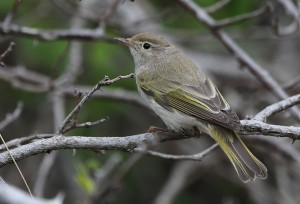 It’s time to leave Nerín, and a stop at the next village is rewarded with Alpine Swifts, another Egyptian Vulture, this time perched in a tree, fantastic views of three Citril Finches pecking grit on the edge of the village, and a close encounter with another blazing Firecrest. We arrive at the Boletas Birdwatching Centre in time for lunch in the garden, where the sixteenth century building with thick rock solid walls, low beamed ceilings and chunky stone archways is our home for the next two nights. Dozens of Swifts scream around the ancient crumbling church tower, Black Redstarts and Spotless Starlings whistle from the terracotta roof tops, colonies of House Martins twitter under the eaves and Black Kites and Booted Eagles patrol the neighbouring fields. This afternoon we visit the rugged Sierra de Guara, where the scolding Crag Martins dive at our heads! High above there are loads of Griffons, along with Egyptian Vultures, Honey Buzzards, a Peregrine and yet another Lammergeier! Back in the floral countryside with the rich scent of Honeysuckle, there are numerous exotic looking Bee-eaters, along with Thekla Lark, Red-rumped Swallow, Melodious Warbler and Woodchat Shrike, with the unusual combination of Stonechat, Corn Bunting and even Nightingale all singing from the same wire! Not bad for a ‘quiet day’!
It’s time to leave Nerín, and a stop at the next village is rewarded with Alpine Swifts, another Egyptian Vulture, this time perched in a tree, fantastic views of three Citril Finches pecking grit on the edge of the village, and a close encounter with another blazing Firecrest. We arrive at the Boletas Birdwatching Centre in time for lunch in the garden, where the sixteenth century building with thick rock solid walls, low beamed ceilings and chunky stone archways is our home for the next two nights. Dozens of Swifts scream around the ancient crumbling church tower, Black Redstarts and Spotless Starlings whistle from the terracotta roof tops, colonies of House Martins twitter under the eaves and Black Kites and Booted Eagles patrol the neighbouring fields. This afternoon we visit the rugged Sierra de Guara, where the scolding Crag Martins dive at our heads! High above there are loads of Griffons, along with Egyptian Vultures, Honey Buzzards, a Peregrine and yet another Lammergeier! Back in the floral countryside with the rich scent of Honeysuckle, there are numerous exotic looking Bee-eaters, along with Thekla Lark, Red-rumped Swallow, Melodious Warbler and Woodchat Shrike, with the unusual combination of Stonechat, Corn Bunting and even Nightingale all singing from the same wire! Not bad for a ‘quiet day’!
It’s our last day in the field, and we begin with two Rock Sparrows right outside the front door! The lovely countryside around the village has a wonderful soundtrack with Woodlark, Nightingale, Melodious Warbler and Corn Bunting all joining in, but the star performer is an Orphean Warbler singing from the very top of a dead bush, providing a superb view in the scope. There is plenty of action in the valley below our vantage point, where we spot Thekla Lark, Blue Rock Thrush, purring Turtle Doves, a stunningly vivid yellow male Golden Oriole in full view and a party of three impressive Wild Boar, before rain stops play and we return ‘home’ for elevenses.
We have seen Bonelli’s Warbler but we still need his eagle, so this is Joan’s task this afternoon, but it’s a tall order as there is only one known female remaining in the entire area! Just twenty minutes from ‘home’ are high pink cliffs peppered by Griffons, but no eagle, so Joan phones a friend for advice. The ‘dial a bird’ service suggests we try another track a little further west, where another scan reveals a Cuckoo sitting perfectly still on a rock. Suddenly Joan shouts “Bingo”, and there she is standing proud on top of the last pylon to be checked, and looking down with an air of majesty. Even from a distance she looks massive and the view in the scope is sensational with boldly speckled white underparts and a long dark tipped tail, which she fans out while preening. Finding this single bird in such a large remote area is simply remarkable, so it’s high fives all round again. Well done Joan. But he still wants to show us one more local speciality, despite the onset of heavy rain, so we head for the castle ruins on the top of Montearagón. The wind and rain are not conducive to good birding but the Corn Buntings, Black Redstart and another handsome male Black-eared Wheatear keep our hopes up, although standing in pouring diagonal rain looking for a small bird in a big landscape does seem bonkers. Just as we are about to throw in the towel and go for an early bath, a faint song emanating from the rocks, reveals our quarry, the locally rare Black Wheatear, in the scope at last, followed by spontaneous applause, smiles and handshakes. ¡Fantastico!
With a trip list of 163 different birds, many from the ‘top drawer’, seen in a variety of spectacular landscapes, this has been an amazing trip. How many U3A birding groups can claim to have achieved such success? Muchas gracias to Joan, for his excellent guidance and dedication.

